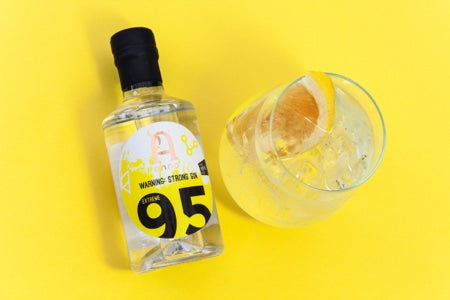Anno gin conversation starters
Gin facts to get you back into the pub spirit
1. The Anno logo is also an alchemy symbol for distillation. Alchemy has a complex, varied history and it played a large role in the formation of modern chemistry and medicine. Ancient alchemists worked to purify and perfect certain materials by using processes and elements, with a collection of symbols to represent and record their work. Anno bottles also feature more of these symbols as a hint to the contents and our motto 'The Spirit of Alchemy' ties it all together
2. ANNO comes from our scientist founders' names. The first two letters of each, ANdy & NOrman, combine into the name you know.
3. Ever looked at our popular Anno Kent Dry Gin bottle? The word strings entwined around the bottle represent hop vines, a very traditional Kentish sight and one of the floral ingredients in our flagship gin. The empty bottles are sought-after by people making lamps and other crafted gifts. (Photo courtesy of Jess Loughrey)
4. The 16 botanicals in Anno Kent Dry Gin, which is also the base for Anno Sloe Gin, can be found in every part of the Kent county and beyond. These are: a blend of Kentish hops, a handpicked lavender blend from Downderry Nursery, rural florals - foraged elderflower, rose hips and camomile. Other flavour comes from coastal samphire which has been grown in Kent for centuries, the not so Kentish ingredients are whole fresh lemon, Seville orange, kaffir lime leaves, juniper berries, coriander seeds, orris root, angelica root, cassia bark, liquorice, and cubebs.
5. The honey and bee pollen in Anno Orange & Honey Gin come from the Local Honey Man and a donation from every bottle sold goes to Bee Friendly Trust charity. (Photo by Caragh & Chanelle Photography)
6. The number 3 in Anno B3rry Pink Gin represents the three Kentish berries found in the recipe, it's a gorgeous blend of juicy strawberries, blackberries, elderberries and other delicious flavours.
7. Anno 60² Gin was created as a special edition release to mark the founders' 60th birthdays before becoming a permanent addition due to popular demand. The spiced, woody flavour and overproof 60% ABV give it a smooth character like a good whisky.
8. The medicinal origins of gin and tonic come from the use of quinine, which for a long time was thought to cure malaria and repel mosquitos. In the 1700s, doctors studied that larger amounts of quinine added to water could be used to prevent the disease. The bitterness proved too much for the British soldiers in India, who later added sugar and lime, along with their gin ration, to improve the flavour. Lime or lemon juice added much-needed vitamin C to ward off scurvy. Now, Indian tonic waters contain less quinine and added sweeteners, and lime remains the garnish of choice for many gin distilleries. The modern Gin & Tonic was born but recent studies have found that the amount of quinine needed to keep malaria at bay would never fit into a round of G&Ts and so it's no longer recommended as a cure! Read more about the history of gin here. (Image: The meeting of Lord Clive with Meer Jaffier, after the battle of Plassey. Illustration from The Comprehensive History of England - Gresham Publishing, 1902)
9. Ever wondered where the word 'proof' originates in the world of spirits? It started in the Royal Navy in the 18th century when officers mixed gin and gunpowder, lighting it and observing the flame. This was done so if the gunpowder on board ever came into contact with the spirit, it would still be effective. A clear flame was ‘proof’ of the gin's quality and became a new standard, so eventually anything 114 proof (or 57.1% ABV) was considered safe enough to carry on board and good enough for a decent drink. The phrase wasn't used until decades later, when a marketer decided to use it as a way to sell stronger, 'navy strength' spirits. Our Anno Extreme 95 Gin has since set a new record for gin strength,
10. 'Dutch courage' is a phrase many of us have used to explain a burst of bravery (for better or worse). A few versions of events place its origins in the early 1600s and the Dutch army fighting with help from British soldiers. The Dutch were said to have had a drink of medicinal 'genever' (an early form of gin) before battle, giving them a calmness that was taken to be courage by the other soldiers. (Image: The Cavalcade of the Prince of Nassau by Adriaen Pietersz van de Venne)
So there you have it, ten gin facts (and some folk tales) to spark a conversation over your next social drink
Got any of your own? Head over to our socials and share them with us @annodistillers on Facebook, Instagram and Twitter. We'll put the best ones on our pages and give you a shout out.

